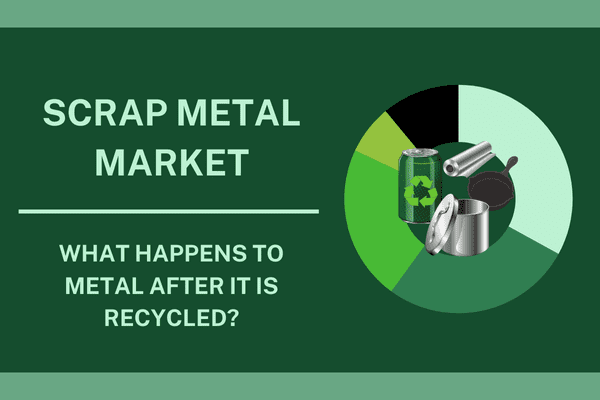
When it comes to improving your company, there are certain things to take into consideration that impact your day-to-day operations. More specifically, optimizing your workflows, modernizing your technology, and solidifying your manufacturing recycling processes are often the first steps for improvement.
But, what if we told you there is a way to improve your business AND contribute to a better environment simultaneously? According to the EPA, more than 30% of the average American’s carbon footprint comes from manufacturing processes. While this is unfortunate news, many manufacturing companies are taking initiatives to lessen their negative impact on the environment.
Fortunately, there are ways to help save you money, reduce your carbon footprint, and improve your business all at the same time. If your business, like most manufacturing companies, is trying to find ways to cut costs while reducing your carbon output, then you might want to consider establishing a sustainable manufacturing recycling program.
A few simple changes in your manufacturing processes and waste management can go a long way in helping you become a green manufacturer. Recycling is not only good for the environment, but it can also be a great way to save money and improve your business.
How Manufacturing Recycling Sustains Businesses
It seems obvious that recycling is a good way to protect the environment, but it’s also a great business strategy for manufacturers. By recycling, you’re actually saving money. Moreover, you’re reducing your costs, which allows you to invest in your business, rather than spending your money on unnecessary resources.
It is crucial for manufacturers to use recycled metals as opposed to mining for new metals because it reduces energy consumption and the depletion of natural resources.
Technological Recycling Advancements
While recycling already plays a significant role in the manufacturing industry, there is always room for advancements in sustainable processes and technologies. The Institute of Scrap Recycling Industries (ISRI) states that 70% of recycled materials are used in the manufacturing industry of the United States.
For manufacturing recycling, the goal is to create a circular economy that ideally eliminates waste in the manufacturing process. With inventions like electric arc furnace technology, scrap metal such as steel can be repurposed.
Steel is the perfect recyclable material because it can be infinitely reused from end-of-life products, like appliances, automobiles, machinery, electronic equipment, etc., and formed into new steel products. The electric arc furnace produces recycled steel products from a fraction of the carbon emissions per ton in comparison to producing virgin materials.
Improving Your Processes With Green Manufacturing

As mentioned above, the ultimate objective of manufacturing recycling is to achieve a circular economy that transforms production and supply chain processes and creates consumer demand for sustainable products. In order to do so, manufacturers must make concrete efforts to move toward green manufacturing.
What is Green Manufacturing?
Green manufacturing takes into account the environment and natural resources as a part of the manufacturing process. By manufacturing goods using green technologies, including alternative energy and methods that reduce waste, environmental pollution, and overall energy usage, companies can significantly decrease their negative impact on the planet.
The Benefits of Green Manufacturing and Recycling
Because there are numerous benefits of green manufacturing, more and more companies are adopting sustainable practices to ensure that their processes are as least harmful as possible. So, let’s discuss some of the main advantages of manufacturing recycling and going green.
1. Cost Savings

Since an aspect of becoming a green manufacturer means reducing your consumption of resources and raw materials, you will be saving your company money. By implementing initiatives such as pollution reduction, energy savers, and economical drivers, you can…
- Reduce taxes to the government
- Minimize energy costs
- Lessen fuel costs
- Decrease costs of sourcing new materials
2. Advancements In Innovation
Similar to what we mentioned about the electric arc furnace, new technologies are being invented to increase productivity and reduce the impact on the environment.
Companies are finding ways to leverage renewable energy, and this means that more companies are investing in advanced ways to run their processes without harming the environment.
3. Tax Benefits
There are many incentives offered by state and national governments that reward green manufacturing practices because they also want to take steps for a more environmentally friendly country.
Some of these include:
- Commercial energy efficiency tax deductions
- Carbon capture tax credits
- Advanced manufacturing production credits
commercial electric vehicle & biodiesel tax credits
4. Improved Reputation
It’s no secret that people like to support sustainable companies. Going green will not only improve your brand recognition, it will also boost your public relations.
In addition, employees want to work with companies whose values align with theirs, and they will feel more satisfied with their work knowing they are contributing to a better environment.
So, green manufacturing actually improves employee morale. This also helps employees be more productive, and green manufacturing can also help avoid the risks of injuries on the job that accompany handling heavy materials.
5. Increased Profit and Shareholder Value
Because sustainability is of growing interest for consumers, implementing green manufacturing and marketing your brand as environmentally conscious will open your company up to a whole new target audience. Customers will see your company as a leader in environmental responsibility. Thus, your sales will increase.
According to Bob Willard, a leader in environmental sustainability, companies that integrate best-practice sustainability approaches can improve profits by at least 51% to 81% within three to five years.
Now that you know some of the benefits of going green, we can discuss how you can start to implement sustainability practices in your company.
How to Start Manufacturing Recycling at Your Facility
First things first, you should talk to your CEO about starting a recycling program at your manufacturing facility. With the knowledge of all the benefits that green manufacturing can provide for your business, they are bound to get on board.
Your company should appoint a team leader who is in charge of the recycling efforts and makes sure that every employee is correctly following procedures and environmental standards. Then, you should conduct a formal scrap audit to examine your collection, sorting, and recycling processes.
Your business will save so much money by recycling not only metal (ferrous and non-ferrous), but also plastic, cardboard, paper, wood, and other recyclable materials. Once you find and integrate the right equipment, tools, and safety measures for sustainable manufacturing, you can reap the benefits of continuously improving your business operations.
If implementing these processes seems overwhelming, you can always work with a recycling team. You can also sell your old equipment, scrap parts, and old supplies to third-party companies to cover the costs of recycling them.
Streamline Recycling at Your Manufacturing Plant

In today’s world, manufacturing is one of the most important functions of business, but also one of the largest producers of pollution and waste. The future of this industry relies on environmentally conscious practices that reduce manufacturers’ harmful impact on the planet.
Armed with the knowledge from this article, you now know the importance of manufacturing recycling and how it can improve your business.
GLE Scrap Metal purchases, processes, and sells all grades of scrap metal for private companies, demolition organizations, and the general public. With recycling services from GLE Scrap Metal, your manufacturing business can reduce its carbon footprint and create a cleaner environment while also reducing costs and improving profits.
So, let GLE show you how recycling materials can lead to environmental sustainability. For questions or more information about the scrap metal materials we recycle, contact us on our website or call 855-SCRAP-88.


